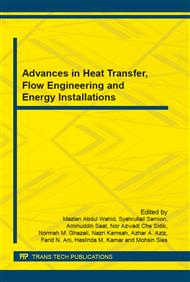[1]
F. Z. Abas. and F. N. Ani. Comparing Characteristics Of Oil Palm Biochar Using Conventional And Microwave Heating. Jurnal Teknologi 68(3): 33-37, (2014).
DOI: 10.11113/jt.v68.2926
Google Scholar
[2]
R. Zanzi, X. Bai, P. Capdevila and E. Bjornbom. Pyrolysis of biomass in presence of steam for preparation of activated carbon, liquid and gaseous products. 6th World Congress of Chemical Engineering Melbourne, Australia. 1-8, (2001).
Google Scholar
[3]
M. A. Alkhatib, S. Muyibi and J. Amode. Optimization of activated carbon production from empty fruit bunch fibers in one-step steam pyrolysis for cadmium removal from aqueous solution. The Environmentalist 31(4): 349-357, (2011).
DOI: 10.1007/s10669-011-9342-9
Google Scholar
[4]
T. Y. Jun, S. D. Arumugam, N. H. A. Latip, A. M. Abdullah and P. A. Latif. Effect of activation temperature and heating duration on physical characteristics of activated carbon prepared from agriculture waste. The international journal published by the Thai Society of Higher Education Institutes on Environment EnvironmentAsia 3(special issue): 143-148, (2010).
Google Scholar
[5]
K. Y. Foo and B. H. Hameed. Microwave-assisted preparation of oil palm fiber activated carbon for methylene blue adsorption. Chemical Engineering Journal 166(2): 792-795, (2011).
DOI: 10.1016/j.cej.2010.11.019
Google Scholar
[6]
W. M. A. W. Daud, W. S. W. Ali and M. Z. Sulaiman. The effects of carbonization temperature on pore development in palm-shell-based activated carbon. Carbon 38(14): 1925-1932. (2000).
DOI: 10.1016/s0008-6223(00)00028-2
Google Scholar
[7]
R. Hoseinzadeh Hesas, A. Arami-Niya, W. M. A. Wan Daud and J. N. Sahu. Preparation of granular activated carbon from oil palm shell by microwave-induced chemical activation: Optimisation using surface response methodology. Chemical Engineering Research and Design, 91(12), 2447–2456, (2013).
DOI: 10.1016/j.cherd.2013.06.004
Google Scholar
[8]
J. Nwabanne and P. Igbokwe. Mechanism of copper (II) removal from aqueous solution using activated carbon prepared from different agricultural materials. International Journal Of Multidisciplinary Sciences And Engineering, 3(7): 46-52, (2012).
Google Scholar
[9]
R. Wahi and H. Senghie. The Use of Microwave Derived Activated Carbon for Removal of Heavy Metal in Aqueous Solution. Journal of Science and Technology 3(1): 97-108, (2011).
Google Scholar
[10]
M. Rafatullah, T. Ahmad, A. Ghazali, O. Sulaiman, M. Danish and R. Hashim. Oil Palm Biomass as a Precursor of Activated Carbons: A Review. Critical Reviews in Environmental Science and Technology 43(11): 1117-1161, (2013).
DOI: 10.1080/10934529.2011.627039
Google Scholar
[11]
K. Y. Foo and B. H. Hameed. Preparation of oil palm (Elaeis) empty fruit bunch activated carbon by microwave-assisted KOH activation for the adsorption of methylene blue. Desalination 275(1–3): 302-305, (2011).
DOI: 10.1016/j.desal.2011.03.024
Google Scholar
[12]
B. H. Hameed, I. A. W. Tan and A. L. Ahmad. Preparation of oil palm empty fruit bunch-based activated carbon for removal of 2, 4, 6-trichlorophenol: Optimization using response surface methodology. Journal of Hazardous Materials 164(2–3): 1316-1324, (2009).
DOI: 10.1016/j.jhazmat.2008.09.042
Google Scholar
[13]
B. K. Hamad, A. M. Noor, A. R. Afida and M. N. Mohd Asri. High removal of 4-chloroguaiacol by high surface area of oil palm shell-activated carbon activated with NaOH from aqueous solution. Desalination 257(1–3): 1-7, (2010).
DOI: 10.1016/j.desal.2010.03.007
Google Scholar
[14]
I. A. W. Tan, B. H. Hameed and A. L. Ahmad. Equilibrium and kinetic studies on basic dye adsorption by oil palm fibre activated carbon. Chemical Engineering Journal 127(1–3): 111-119, (2007).
DOI: 10.1016/j.cej.2006.09.010
Google Scholar
[15]
R. Hoseinzadeh Hesas, A. Arami-Niya, W. M. A. Wan Daud and J. N. Sahu. Comparison of oil palm shell-based activated carbons produced by microwave and conventional heating methods using zinc chloride activation. Journal of Analytical and Applied Pyrolysis 104(0): 176-184, (2013).
DOI: 10.1016/j.jaap.2013.08.006
Google Scholar
[16]
Á. Linares Solano, M. Á. Lillo Ródenas, J. P. Marco Lozar, M. Kunowsky and A. J. Romero Anaya. NaOH and KOH for preparing activated carbons used in energy and environmental applications. International Journal of Energy, Environment and Economics, 20(4): 59-91, (2012).
Google Scholar
[17]
A. Okhovat, A. Ahmadpour, F. Ahmadpour and Z. Khaki Yadegar. Pore Size Distribution Analysis of Coal-Based Activated Carbons: Investigating the Effects of Activating Agent and Chemical Ratio. ISRN Chemical Engineering 2012: 1-10. (2012).
DOI: 10.5402/2012/352574
Google Scholar
[18]
J. Guo and A. C. Lua. Preparation of activated carbons from oil-palm-stone chars by microwave-induced carbon dioxide activation. Carbon 38(14): 1985-1993, (2000).
DOI: 10.1016/s0008-6223(00)00046-4
Google Scholar
[19]
J. Guo and A. Chong Lua. Characterization of chars pyrolyzed from oil palm stones for the preparation of activated carbons. Journal of Analytical and Applied Pyrolysis 46(2): 113-125, (1998).
DOI: 10.1016/s0165-2370(98)00074-6
Google Scholar


